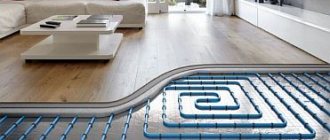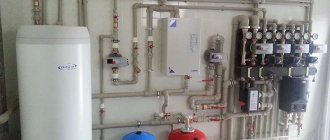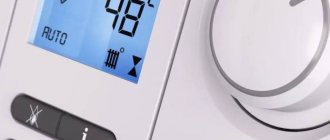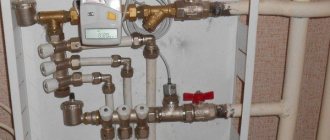the installation of a heat meter in an apartment itself
is not protection against increases in tariffs for consumed resources, but its presence allows you to optimize costs, including through the ability to regulate the temperature in the room. This result is achieved due to the fact that such devices not only serve to account for the consumed coolant, but also provide the consumer with the opportunity to independently regulate the amount of coolant entering the system. In Soviet-built apartments, it is impossible to organize such accounting, due to the peculiarities of the heating systems, but the best option in such cases is to install building-wide heat meters, which also serve for accounting, while the amount of consumed heat resources is divided among all apartments, in proportion to the heated area. But it must be taken into account that in this case, public areas are also taken into account and taken into account: entrances, corridors, etc.
The need to install heat meters in apartments and houses
It should be noted that the law
obliges developers to equip all separate residential premises in houses for rent with individual metering devices. One of the by-laws is Decree of the Government of the Russian Federation No. 1708 of December 28, 2022, according to which changes are made to the rules for the provision of utility services, including those related to heat supply services, to owners and other users of premises in apartment buildings and other residential buildings. According to the resolution, every owner or tenant of a residential premises has the right to install an apartment heat meter, regardless of whether such devices are installed in other apartments. At the same time, the responsibility of management companies (or homeowners associations) is that they must register the heat meter and make charges for consumed heat solely based on the readings of the device.
However, it is imperative to take into account that before proceeding with the selection of a meter and installation of equipment, you must first obtain permission from the service provider (in each specific case, these may be different organizations, but most often it is a management company or a homeowners association). This is followed by:
- prepare design documentation;
- submit it for approval to the supplying organization;
- Next - carry out installation work, after which you must again contact the service provider, who will send a specialist to seal the device.
You should definitely know that, in addition to the heat meter, temperature sensors and connecting fittings are also subject to sealing.
ORDER A SERVICE FROM ACCREDITED COMPANIES
How to properly install a heat meter in a house
It should be noted that it is recommended to entrust all work related to the development of the project and installation of equipment to an organization for the installation of heat meters
, whose specialists are sufficiently qualified to carry out such work, and the company itself has the necessary permits and licenses. When installing a heat meter, you can only save money by turning to professionals - attempting to install it yourself or with the help of a familiar technician can result in both financial and time losses. But when choosing an organization, you need to pay attention to whether it has:
- accreditation and registration of the company in the Unified State Register of Legal Entities;
- title documents, certificates, licenses and other permits;
- a complete list of works allowing the company to install a turnkey heat meter;
- metrological and other laboratory equipment;
- the ability to assume warranty obligations.
You should also pay attention to other aspects, namely:
- the ability to provide service during equipment operation;
- the reputation of the company, which you can ask about either from clients, or by looking at reviews of consumers of services;
- efficiency of work.
The general algorithm for cooperation between the customer and the contractor is as follows:
- First, a contract is concluded, on the basis of which the design is prepared, approved, and installed;
- after installation, a work acceptance certificate is drawn up;
- further, a warranty and/or service agreement may be concluded;
- the next step is putting the equipment into operation, which is confirmed by the act;
- sealing (a representative of the heat supply company is invited for this stage of work).
The customer may request from the contractor a copy of the permit for installation work, and he also has the right to receive a technical passport of the heat meter with a quality certificate.
After all the documents are in the possession of the customer - the owner of the premises, he must register them by contacting the heating service provider company.
Cost of installation of metering devices: factors influencing the final price
Initially, you should take into account that the cost of installing heat meters in an apartment
includes not only the price of the device itself, but also:
- project development;
- installation work;
- technical support.
In addition, other factors influence the final price of installing a heat meter in an apartment, the main ones being:
- wiring diagram of the heating system in an apartment or house;
- pipe diameter and material;
- accessibility of nodal points for installation;
- difficulty in installing the selected meter model;
- technical features of the building itself in which the equipment is planned to be installed: load on the system, pressure in the pipes and other points;
- the need for additional work.
Also included in the cost of installing a heat meter are the costs of purchasing consumables and additional materials, the list of which is determined individually. As a rule, additionally purchased:
- various types of components: filters, pipes, collet connections, etc.;
- connection kit;
- check valves;
- taps, intended, among other things, for installing sensors and other elements of the metering device.
Taking into account the fact that the installation of equipment for metering thermal energy consumption is a rather complex technical process associated with the need to correctly document all stages of the work, it is not recommended to install metering devices independently, as this will require large financial and time costs. Involving specialists allows you to avoid many mistakes, and in addition, complete the work in the shortest possible time.
Service life of an in-house heat meter.
The lifetime warranty is 12 years, this is the service life of the heat meter , you can carry out state verification after this period, but only for one year and without a guarantee that your heat meter will pass the test, and the money is just that, that. Yes, our state will not leave our people without work, and itself without income from this work to the treasury.
But I'm going off topic. The takeoff was the first and the first to cause problems in the courts. I don’t know who was right, but to this day the Vzlet heat meters are criticized for the lack of universality of the software, and energy supply organizations whisper that the flow meters of these meters, in order to eliminate errors from water quality, can adjust to each other without showing obvious leaks.
They don’t like logic for the complexity of processing readings, and the same energy supply organizations say that the measurement accuracy of devices is easily changed by external software. I’m not an expert, as I don’t understand, but I personally don’t need complaints from thermal engineers either. Although the same thermal engineers are happy to use Logic heat meters at their boiler houses, supplying heat to our houses with central heating . Here, too, it’s worth thinking about, maybe their heat meters really attribute Gcal to us, this is how Heating Networks write off their losses due to negligence.
I also came across heat meters from Uraltechnologies and MKTS, but the manufacturers of the former are far from us, and the reliability of the latter causes great complaints among residents of apartment buildings with central heating. To put it simply, many of these meters have been abandoned across the country and have not even passed the first verification interval - 4 years.
TV7 heat meter manufactured by TERMOTRONIK CJSC, St. Petersburg.
And what in the end did I buy - “TERMOTRONIK” - a heat meter for houses with central heating based on the TV7 heat meter, produced by the company of the same name, CJSC “TERMOTRONIK”, St. Petersburg.
Why, I’ll be honest, I just liked the supplier’s website, there was too much useful information on it on heat metering, savings, operation, and solving problems with heat meters. Moreover, they sold the Thermotronic heat meter and all its components directly according to the specifications for the project, at a price lower than the factory price. Sent by a transport company three days after payment, this means that we are in different regions and only the money arrived for two days. We received the heat meter just before the New Year, we will install it after the holidays.
The problem of choosing a heat meter model. What factors influence decision making?
An important aspect of cooperation with specialized companies should be considered the opportunity to receive qualified assistance, including in choosing a heat meter model, since the “more expensive is better” principle does not work in this case. When choosing a device, it is important to take into account not only its technical characteristics, but first of all the technical conditions of the existing heating system for operation with which it is planned to install the device.
To install a heating meter
You can use several types of devices that differ not only in appearance, size and brand name, but above all in their operating principle. According to this criterion, heat meters are:
- mechanical;
- ultrasonic;
- electromagnetic and others.
In addition, devices may have additional functions and capabilities. For example, some heat meters are designed to operate in automatic mode with the ability to connect to a single center for data transfer, which greatly simplifies the process of monitoring and accounting for heat resource consumption. Such devices are equipped with special pulse outputs or are capable of supporting the M-bus protocol. In cases where the heat meter is not intended to be integrated with automatic control systems, there is no need to purchase a heat meter with additional functions. Especially considering that, regardless of the type and model of the device, the operation of the heat meter is based on taking into account the consumed coolant and the difference in temperature readings. Based on the data obtained, using the comparison method, the real volume of thermal energy consumption is determined.
When choosing a heat meter model, it is necessary to take into account the nominal diameter of the device (DN), and also take into account the type of wiring in the apartment. The optimal is the horizontal system, which has become the norm when laying pipes in modern houses - in this case, each apartment has a separate entrance (and, accordingly, exit), which makes it easy to organize a heat consumption metering system in a separate living space. In Soviet-built apartments, a fundamentally different wiring method was used - vertical. In this case, the apartment may have several inputs and outputs, which significantly complicates the process of organizing accounting at such facilities. The best option may be to install a common house meter, and it is recommended to organize individual metering using special devices - heat distributors. But we must take into account that in this case it is assumed that such a meter will be installed on each heating radiator.
In systems with vertical wiring, the installation of a heat meter is complicated not only by the need to install them for each radiator, but also for a metrological reason - in some cases it is difficult to achieve a temperature difference of 3 °C between supply and outlet.
When is it possible and advisable to install the device?
Today there is a lot of advertising about how profitable it is to install a heat meter in a home with a centralized heating system, but this is not always true. In old houses with perpendicular wiring, such a procedure will be very expensive since the device must be installed on each battery. Not every specialist will undertake this. There is a benefit where there is a horizontal heating system. And also, saving heat and reducing numbers on payment receipts will only happen if windows and doors are insulated, all cracks are closed, and there is no blowing from the walls.











